Deck 11: Autonomic Nervous System
Question
Question
Question
Question
Question
Question
Question
Question
Question
Question
Question
Question
Question
Question
Question
Question
Question
Question
Question
Question
Question
Question
Question
Question
Question
Question
Question
Question
Question
Question
Question
Question
Question
Question
Question
Question
Question
Question
Question
Question
Question
Question
Question
Question
Question
Question
Question
Question
Question
Question
Question
Question
Question
Question
Question
Question
Question
Question
Question
Question
Question
Question
Question
Question
Question
Question
Question
Question
Question
Question
Question
Question
Question
Question
Question
Question
Question
Question
Question
Question

Unlock Deck
Sign up to unlock the cards in this deck!
Unlock Deck
Unlock Deck
1/82
Play
Full screen (f)
Deck 11: Autonomic Nervous System
1
Somatic motor neurons
A)have long preganglionic fibers
B)release norepinephrine
C)release acetylcholine
D)innervate smooth muscle
E)are regulated by the hypothalamus
A)have long preganglionic fibers
B)release norepinephrine
C)release acetylcholine
D)innervate smooth muscle
E)are regulated by the hypothalamus
C
2
The preganglionic motor neurons of the sympathetic division of the ANS release
A)epinephrine
B)norepinephrine
C)acetylcholine
D)GABA
E)glutamate
A)epinephrine
B)norepinephrine
C)acetylcholine
D)GABA
E)glutamate
C
3
The brain region that controls most autonomic responses is the
A)hypothalamus
B)cerebrum
C)cerebellum
D)thalamus
E)epithalamus
A)hypothalamus
B)cerebrum
C)cerebellum
D)thalamus
E)epithalamus
A
4
The sympathetic division of the ANS does all of the following EXCEPT
A)speeds up digestion so glucose is available to skeletal muscles
B)conducts impulses through the trunk ganglia
C)speeds up heart rate
D)speeds up respiratory rate
E)uses epinephrine as a signaling molecule
A)speeds up digestion so glucose is available to skeletal muscles
B)conducts impulses through the trunk ganglia
C)speeds up heart rate
D)speeds up respiratory rate
E)uses epinephrine as a signaling molecule

Unlock Deck
Unlock for access to all 82 flashcards in this deck.
Unlock Deck
k this deck
5
Preganglionic neurons of the parasympathetic division of the ANS synapse with postganglionic neurons in the
A)sympathetic trunk ganglia
B)celiac ganglia
C)mesenteric ganglia
D)terminal ganglia
E)prevertebral ganglia
A)sympathetic trunk ganglia
B)celiac ganglia
C)mesenteric ganglia
D)terminal ganglia
E)prevertebral ganglia

Unlock Deck
Unlock for access to all 82 flashcards in this deck.
Unlock Deck
k this deck
6
The _____ nervous system contains sensory neurons and motor neurons associated with voluntary actions only.
A)peripheral
B)somatic
C)autonomic
D)central
E)parasympathetic
A)peripheral
B)somatic
C)autonomic
D)central
E)parasympathetic

Unlock Deck
Unlock for access to all 82 flashcards in this deck.
Unlock Deck
k this deck
7
Which of the following is true of BOTH the parasympathetic and sympathetic divisions of the autonomic nervous system?
A)have long preganglionic neurons
B)have ganglia located next to the effectors
C)use acetylcholine as the neurotransmitter in the ganglia
D)use acetylcholine to excite the effector
E)have long postganglionic neurons
A)have long preganglionic neurons
B)have ganglia located next to the effectors
C)use acetylcholine as the neurotransmitter in the ganglia
D)use acetylcholine to excite the effector
E)have long postganglionic neurons

Unlock Deck
Unlock for access to all 82 flashcards in this deck.
Unlock Deck
k this deck
8
All of the following are common effectors of the ANS EXCEPT
A)cardiac muscle
B)smooth muscle
C)skeletal muscle
D)nervous tissue
E)all of the choices are common ANS effectors
A)cardiac muscle
B)smooth muscle
C)skeletal muscle
D)nervous tissue
E)all of the choices are common ANS effectors

Unlock Deck
Unlock for access to all 82 flashcards in this deck.
Unlock Deck
k this deck
9
Which of the following is NOT a characteristic of the preganglionic fibers of the sympathetic division?
A)usually have many branches
B)leave the spinal cord through the anterior root
C)synapse with many postganglionic cell bodies
D)are longer than the postganglionic fibers
E)use acetylcholine as the neurotransmitter
A)usually have many branches
B)leave the spinal cord through the anterior root
C)synapse with many postganglionic cell bodies
D)are longer than the postganglionic fibers
E)use acetylcholine as the neurotransmitter

Unlock Deck
Unlock for access to all 82 flashcards in this deck.
Unlock Deck
k this deck
10
An involuntary effector that receives impulses from both the sympathetic and parasympathetic divisions of the ANS is said to have
A)somatic innervation
B)dual innervation
C)antagonistic innervation
D)synergistic innervation
E)agonistic innervation
A)somatic innervation
B)dual innervation
C)antagonistic innervation
D)synergistic innervation
E)agonistic innervation

Unlock Deck
Unlock for access to all 82 flashcards in this deck.
Unlock Deck
k this deck
11
Which of the following statements does NOT accurately describe a characteristic of the autonomic nervous system?
A)Autonomic pathways consist of two types of motor neurons.
B)ANS stimulation of involuntary effectors is always excitatory.
C)The output (motor)portion of the ANS can be divided into two principal branches.
D)The postganglionic neuron lies entirely in the peripheral nervous system.
E)All of the choices describe characteristics of the ANS.
A)Autonomic pathways consist of two types of motor neurons.
B)ANS stimulation of involuntary effectors is always excitatory.
C)The output (motor)portion of the ANS can be divided into two principal branches.
D)The postganglionic neuron lies entirely in the peripheral nervous system.
E)All of the choices describe characteristics of the ANS.

Unlock Deck
Unlock for access to all 82 flashcards in this deck.
Unlock Deck
k this deck
12
Which of the following statements about the autonomic nervous system (ANS)is NOT true?
A)regulates the size of the pupils
B)uses a single neurotransmitter called acetylcholine
C)consists of two motor subdivisions
D)regulates visceral activities
E)controls involuntary effectors
A)regulates the size of the pupils
B)uses a single neurotransmitter called acetylcholine
C)consists of two motor subdivisions
D)regulates visceral activities
E)controls involuntary effectors

Unlock Deck
Unlock for access to all 82 flashcards in this deck.
Unlock Deck
k this deck
13
The neurotransmitter released by postganglionic fibers in the parasympathetic division is
A)glycine
B)acetylcholine
C)acetylcholinesterase
D)dopamine
E)norepinephrine
A)glycine
B)acetylcholine
C)acetylcholinesterase
D)dopamine
E)norepinephrine

Unlock Deck
Unlock for access to all 82 flashcards in this deck.
Unlock Deck
k this deck
14
In the autonomic nervous system, there are ___ neuron(s)between the CNS and the visceral effector.
A)5
B)4
C)3
D)2
E)1
A)5
B)4
C)3
D)2
E)1

Unlock Deck
Unlock for access to all 82 flashcards in this deck.
Unlock Deck
k this deck
15
All of the following events occur during the fight-or-flight response EXCEPT
A)increased heart rate
B)increased blood pressure
C)constriction of the pupils
D)dilation of the bronchioles
E)decreased digestive secretions
A)increased heart rate
B)increased blood pressure
C)constriction of the pupils
D)dilation of the bronchioles
E)decreased digestive secretions

Unlock Deck
Unlock for access to all 82 flashcards in this deck.
Unlock Deck
k this deck
16
Sympathetic preganglionic neurons
A)originate in the brainstem and sacral region of the spinal cord.
B)originate in the cerebrum of the brain.
C)originate in the thoracic and lumbar region of the spinal cord.
D)tend to be relatively long.
E)synapse in the terminal ganglion.
A)originate in the brainstem and sacral region of the spinal cord.
B)originate in the cerebrum of the brain.
C)originate in the thoracic and lumbar region of the spinal cord.
D)tend to be relatively long.
E)synapse in the terminal ganglion.

Unlock Deck
Unlock for access to all 82 flashcards in this deck.
Unlock Deck
k this deck
17
All of the following are sympathetic ganglia EXCEPT
A)sympathetic trunk ganglia
B)celiac ganglia
C)superior mesenteric ganglia
D)basal nuclei
E)inferior mesenteric ganglia
A)sympathetic trunk ganglia
B)celiac ganglia
C)superior mesenteric ganglia
D)basal nuclei
E)inferior mesenteric ganglia

Unlock Deck
Unlock for access to all 82 flashcards in this deck.
Unlock Deck
k this deck
18
The sympathetic division of the ANS is also referred to as the
A)autonomic division
B)craniosacral division
C)thoracolumbar division
D)somatic division
E)ganglionic division
A)autonomic division
B)craniosacral division
C)thoracolumbar division
D)somatic division
E)ganglionic division

Unlock Deck
Unlock for access to all 82 flashcards in this deck.
Unlock Deck
k this deck
19
The first motor neuron in an autonomic pathway is called a/an
A)preganglionic neuron
B)postganglionic neuron
C)autonomic ganglion
D)sympathetic neuron
E)parasympathetic neuron
A)preganglionic neuron
B)postganglionic neuron
C)autonomic ganglion
D)sympathetic neuron
E)parasympathetic neuron

Unlock Deck
Unlock for access to all 82 flashcards in this deck.
Unlock Deck
k this deck
20
The neurotransmitter released by the postganglionic fibers of the sympathetic division is
A)norepinephrine
B)acetylcholine
C)acetylcholinesterase
D)dopamine
E)epinephrine
A)norepinephrine
B)acetylcholine
C)acetylcholinesterase
D)dopamine
E)epinephrine

Unlock Deck
Unlock for access to all 82 flashcards in this deck.
Unlock Deck
k this deck
21
The autonomic nervous system
A)is under voluntary control.
B)is always inhibitory.
C)uses one motor neuron to connect the CNS with its effector.
D)operates without conscious control.
E)innervates skeletal muscles.
A)is under voluntary control.
B)is always inhibitory.
C)uses one motor neuron to connect the CNS with its effector.
D)operates without conscious control.
E)innervates skeletal muscles.

Unlock Deck
Unlock for access to all 82 flashcards in this deck.
Unlock Deck
k this deck
22
One effect of the parasympathetic nervous system on the eye is to
A)move the eye to focus directly on an object.
B)decrease the secretion of tears.
C)change the shape of the retina.
D)constrict the pupil.
E)adjust the shape of the lens for distant vision.
A)move the eye to focus directly on an object.
B)decrease the secretion of tears.
C)change the shape of the retina.
D)constrict the pupil.
E)adjust the shape of the lens for distant vision.

Unlock Deck
Unlock for access to all 82 flashcards in this deck.
Unlock Deck
k this deck
23
The balance between sympathetic and parasympathetic activity or autonomic "tone" is regulated by the
A)hypothalamus
B)thalamus
C)cerebellum
D)medulla oblongata
E)pituitary gland
A)hypothalamus
B)thalamus
C)cerebellum
D)medulla oblongata
E)pituitary gland

Unlock Deck
Unlock for access to all 82 flashcards in this deck.
Unlock Deck
k this deck
24
The parasympathetic nervous system decreases all of the following EXCEPT
A)heart rate
B)respiratory rate
C)digestion
D)pupil size
E)air pathway diameter
A)heart rate
B)respiratory rate
C)digestion
D)pupil size
E)air pathway diameter

Unlock Deck
Unlock for access to all 82 flashcards in this deck.
Unlock Deck
k this deck
25
The axon of the preganglionic neurons, the autonomic ganglia and the postganglionic neurons are all parts of the _____ nervous system.
A)somatic
B)peripheral
C)central
D)somatosensory
E)visceral
A)somatic
B)peripheral
C)central
D)somatosensory
E)visceral

Unlock Deck
Unlock for access to all 82 flashcards in this deck.
Unlock Deck
k this deck
26
Which of the following systems is responsible for controlling skeletal muscle activity?
A)autonomic nervous system
B)sympathetic nervous system
C)parasympathetic nervous system
D)somatosensory system
E)somatic nervous system
A)autonomic nervous system
B)sympathetic nervous system
C)parasympathetic nervous system
D)somatosensory system
E)somatic nervous system

Unlock Deck
Unlock for access to all 82 flashcards in this deck.
Unlock Deck
k this deck
27
The most important aspect of mind body exercise is to be
A)highly flexible.
B)physically strong.
C)open to physical and emotional sensations.
D)in excellent cardiovascular health.
E)highly coordinated.
A)highly flexible.
B)physically strong.
C)open to physical and emotional sensations.
D)in excellent cardiovascular health.
E)highly coordinated.

Unlock Deck
Unlock for access to all 82 flashcards in this deck.
Unlock Deck
k this deck
28
The portion of the nervous system regulating smooth muscle activity is called the
A)central nervous system
B)special sense system
C)autonomic nervous system
D)somatic nervous system
E)somatosensory system
A)central nervous system
B)special sense system
C)autonomic nervous system
D)somatic nervous system
E)somatosensory system

Unlock Deck
Unlock for access to all 82 flashcards in this deck.
Unlock Deck
k this deck
29
The word "autonomic" literally means
A)self starting
B)involuntary control
C)self law
D)self inflicted
E)self motivated
A)self starting
B)involuntary control
C)self law
D)self inflicted
E)self motivated

Unlock Deck
Unlock for access to all 82 flashcards in this deck.
Unlock Deck
k this deck
30
Insulin secretion from the pancreas is promoted by the activity of the
A)sympathetic division
B)pituitary gland
C)somatic nervous system
D)parasympathetic division
E)pineal gland
A)sympathetic division
B)pituitary gland
C)somatic nervous system
D)parasympathetic division
E)pineal gland

Unlock Deck
Unlock for access to all 82 flashcards in this deck.
Unlock Deck
k this deck
31
The adrenal glands release epinephrine and norepinephrine to intensify and prolong the effects elicited by _____ postganglionic neurons.
A)CNS
B)endocrine
C)somatic
D)parasympathetic
E)sympathetic
A)CNS
B)endocrine
C)somatic
D)parasympathetic
E)sympathetic

Unlock Deck
Unlock for access to all 82 flashcards in this deck.
Unlock Deck
k this deck
32
An abnormally large colon caused by improperly developed parasympathetic neurons to the distal end of the colon is called
A)hypercolon
B)ulcerative colitis
C)mesocolon
D)megacolon
E)Horner's syndrome
A)hypercolon
B)ulcerative colitis
C)mesocolon
D)megacolon
E)Horner's syndrome

Unlock Deck
Unlock for access to all 82 flashcards in this deck.
Unlock Deck
k this deck
33
The acronym "SLUDD" is a convenient way to remember the responses of
A)somatic motor system
B)parasympathetic division
C)"fight or flight" division
D)somatosensory system
E)endocrine system
A)somatic motor system
B)parasympathetic division
C)"fight or flight" division
D)somatosensory system
E)endocrine system

Unlock Deck
Unlock for access to all 82 flashcards in this deck.
Unlock Deck
k this deck
34
Which of the following responses is a sympathetic response?
A)increased bile secretion
B)increased breakdown of triglycerides in adipose tissue
C)vasodilation leading to erection of the penis (men)and clitoris (women)
D)promotion of insulin secretion
E)all of the choices are correct
A)increased bile secretion
B)increased breakdown of triglycerides in adipose tissue
C)vasodilation leading to erection of the penis (men)and clitoris (women)
D)promotion of insulin secretion
E)all of the choices are correct

Unlock Deck
Unlock for access to all 82 flashcards in this deck.
Unlock Deck
k this deck
35
Nearly 80% of parasympathetic outflow to the terminal ganglia is conducted through
A)the glossopharyngeal nerve.
B)the oculomotor nerve.
C)the vagus nerve.
D)spinal nerves from the thoracic region.
E)spinal nerves from the sacral region.
A)the glossopharyngeal nerve.
B)the oculomotor nerve.
C)the vagus nerve.
D)spinal nerves from the thoracic region.
E)spinal nerves from the sacral region.

Unlock Deck
Unlock for access to all 82 flashcards in this deck.
Unlock Deck
k this deck
36
Horner's syndrome is
A)caused by loss of parasympathetic control of one side of the body.
B)characterized by increased twitching and sweating.
C)only seen in the elderly.
D)caused by a loss of sympathetic control to one side of the face.
E)all of the choices are correct.
A)caused by loss of parasympathetic control of one side of the body.
B)characterized by increased twitching and sweating.
C)only seen in the elderly.
D)caused by a loss of sympathetic control to one side of the face.
E)all of the choices are correct.

Unlock Deck
Unlock for access to all 82 flashcards in this deck.
Unlock Deck
k this deck
37
Which of the following is NOT an accurate description of a potential path followed by a preganglionic sympathetic neuron?
A)synapse with a postganglionic neuron in the sympathetic trunk ganglion
B)ascend or descend the trunk ganglia and synapse at another level
C)continue through the trunk ganglia and synapse in a prevertebral ganglion
D)continue through the trunk ganglia and synapse in a terminal ganglion
E)extend directly to the adrenal medulla
A)synapse with a postganglionic neuron in the sympathetic trunk ganglion
B)ascend or descend the trunk ganglia and synapse at another level
C)continue through the trunk ganglia and synapse in a prevertebral ganglion
D)continue through the trunk ganglia and synapse in a terminal ganglion
E)extend directly to the adrenal medulla

Unlock Deck
Unlock for access to all 82 flashcards in this deck.
Unlock Deck
k this deck
38
All of the following are effects of the parasympathetic division EXCEPT
A)conserving body energy
B)restoring body energy
C)dilation of pupils
D)promoting digestion
E)increasing bile secretion
A)conserving body energy
B)restoring body energy
C)dilation of pupils
D)promoting digestion
E)increasing bile secretion

Unlock Deck
Unlock for access to all 82 flashcards in this deck.
Unlock Deck
k this deck
39
The ANS ganglia that run vertically along both sides of the backbone are called the
A)sympathetic trunk ganglia
B)terminal ganglia
C)parasympathetic ganglia
D)prevertebral ganglia
E)superior mesenteric ganglia
A)sympathetic trunk ganglia
B)terminal ganglia
C)parasympathetic ganglia
D)prevertebral ganglia
E)superior mesenteric ganglia

Unlock Deck
Unlock for access to all 82 flashcards in this deck.
Unlock Deck
k this deck
40
An inherited disorder in which the ANS functions abnormally resulting in symptoms like reduced tear gland secretion, motor incoordination, skin blotching and difficulty swallowing is called
A)autonomic dysreflexia
B)dysautonomia
C)Raynaud phenomenon
D)SLUDD
E)hypotension
A)autonomic dysreflexia
B)dysautonomia
C)Raynaud phenomenon
D)SLUDD
E)hypotension

Unlock Deck
Unlock for access to all 82 flashcards in this deck.
Unlock Deck
k this deck
41
One of the abnormalities caused by Horner's syndrome is a megacolon.

Unlock Deck
Unlock for access to all 82 flashcards in this deck.
Unlock Deck
k this deck
42
Learning relaxation and stress reduction skills can reduce the harmful effects of stress on the body.

Unlock Deck
Unlock for access to all 82 flashcards in this deck.
Unlock Deck
k this deck
43
Pre- and postganglionic fibers are present in the somatic nervous system.

Unlock Deck
Unlock for access to all 82 flashcards in this deck.
Unlock Deck
k this deck
44
The outflow of parasympathetic nerve impulses originates in the brain and sacral region of the spinal cord.

Unlock Deck
Unlock for access to all 82 flashcards in this deck.
Unlock Deck
k this deck
45
Which of the following situations is NOT commonly associated with sympathetic activation?
A)exercise
B)emergency
C)excitement
D)eating
E)embarrassment
A)exercise
B)emergency
C)excitement
D)eating
E)embarrassment

Unlock Deck
Unlock for access to all 82 flashcards in this deck.
Unlock Deck
k this deck
46
Parasympathetic ganglia are usually found near or within visceral effectors.

Unlock Deck
Unlock for access to all 82 flashcards in this deck.
Unlock Deck
k this deck
47
The sympathetic division promotes changes in the body associated with increased energy expenditure.

Unlock Deck
Unlock for access to all 82 flashcards in this deck.
Unlock Deck
k this deck
48
The hypothalamus regulates the balance between sympathetic and parasympathetic activity.

Unlock Deck
Unlock for access to all 82 flashcards in this deck.
Unlock Deck
k this deck
49
The preganglionic neurons that innervate the adrenal medulla release acetylcholine.

Unlock Deck
Unlock for access to all 82 flashcards in this deck.
Unlock Deck
k this deck
50
Parasympathetic stimulation increases sweat secretion.

Unlock Deck
Unlock for access to all 82 flashcards in this deck.
Unlock Deck
k this deck
51
The autonomic nervous system innervates skeletal muscles.

Unlock Deck
Unlock for access to all 82 flashcards in this deck.
Unlock Deck
k this deck
52
The terminal ganglion that houses the synapses involved in parasympathetic control of the ciliary muscle and circular muscles of the iris of the eye is the
A)ciliary ganglion
B)pterygopalatine ganglion
C)submandibular ganglion
D)otic ganglion
E)celiac ganglion
A)ciliary ganglion
B)pterygopalatine ganglion
C)submandibular ganglion
D)otic ganglion
E)celiac ganglion

Unlock Deck
Unlock for access to all 82 flashcards in this deck.
Unlock Deck
k this deck
53
Both the parasympathetic and sympathetic divisions use two different types of neurotransmitters in the output pathways that stimulate their effectors.

Unlock Deck
Unlock for access to all 82 flashcards in this deck.
Unlock Deck
k this deck
54
The effects of the adrenal medulla are linked to the activity of the parasympathetic nervous system.

Unlock Deck
Unlock for access to all 82 flashcards in this deck.
Unlock Deck
k this deck
55
The dilation of the pupils in the eye is an autonomic response.

Unlock Deck
Unlock for access to all 82 flashcards in this deck.
Unlock Deck
k this deck
56
Because of its connection to "fight or flight" response, increased sympathetic stimulation is connected to acute stress reactions.

Unlock Deck
Unlock for access to all 82 flashcards in this deck.
Unlock Deck
k this deck
57
Terminal ganglia are part of the sympathetic division of the ANS.

Unlock Deck
Unlock for access to all 82 flashcards in this deck.
Unlock Deck
k this deck
58
The outflow of parasympathetic nerve impulses is carried exclusively in cranial nerves.

Unlock Deck
Unlock for access to all 82 flashcards in this deck.
Unlock Deck
k this deck
59
Fear stimulates the activation of the parasympathetic division of the ANS.

Unlock Deck
Unlock for access to all 82 flashcards in this deck.
Unlock Deck
k this deck
60
The parasympathetic nervous system has long preganglionic axons and short postganglionic axons.

Unlock Deck
Unlock for access to all 82 flashcards in this deck.
Unlock Deck
k this deck
61
Describe the anatomical differences between the two divisions of the ANS. Name the neurotransmitters used by each type of neuron found in the two divisions.

Unlock Deck
Unlock for access to all 82 flashcards in this deck.
Unlock Deck
k this deck
62
Some autonomic effectors, like sweat glands and blood vessels, are only innervated by the sympathetic division.

Unlock Deck
Unlock for access to all 82 flashcards in this deck.
Unlock Deck
k this deck
63
Parasympathetic responses usually involve the simultaneous activation of a large number of effectors.

Unlock Deck
Unlock for access to all 82 flashcards in this deck.
Unlock Deck
k this deck
64
Autonomic dysreflexia is related to spinal cord injury and involves activation of the sympathetic nervous system.

Unlock Deck
Unlock for access to all 82 flashcards in this deck.
Unlock Deck
k this deck
65
Autonomic dysreflexia is a severe condition observed primarily in individuals that have previously experienced strokes, seizures or heart attacks.

Unlock Deck
Unlock for access to all 82 flashcards in this deck.
Unlock Deck
k this deck
66
Which of the diagrams in the figure shows a motor pathway that uses acetylcholine as a neurotransmitter? 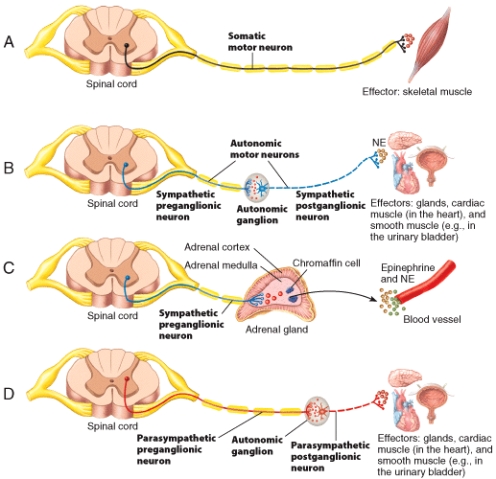
A)A
B)B
C)C
D)D
E)All of the pathways shown use acetylcholine.

A)A
B)B
C)C
D)D
E)All of the pathways shown use acetylcholine.

Unlock Deck
Unlock for access to all 82 flashcards in this deck.
Unlock Deck
k this deck
67
What portion of the nervous system is shown in this diagram? 
A)somatic nervous system
B)somatosensory nervous system
C)sympathetic division of ANS
D)parasympathetic division of ANS
E)enteric nervous system (ENS)

A)somatic nervous system
B)somatosensory nervous system
C)sympathetic division of ANS
D)parasympathetic division of ANS
E)enteric nervous system (ENS)

Unlock Deck
Unlock for access to all 82 flashcards in this deck.
Unlock Deck
k this deck
68
Which of the diagrams in the figure shows a motor pathway that is under voluntary control? 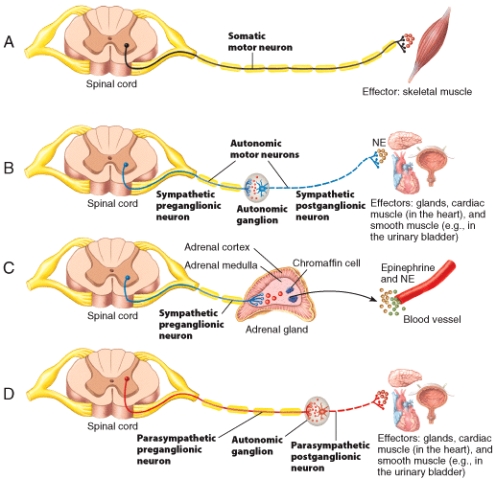
A)A
B)B
C)C
D)D
E)More than one of the pathways is voluntary.

A)A
B)B
C)C
D)D
E)More than one of the pathways is voluntary.

Unlock Deck
Unlock for access to all 82 flashcards in this deck.
Unlock Deck
k this deck
69
Which of the labeled structures in the diagram is the sympathetic chain ganglion? 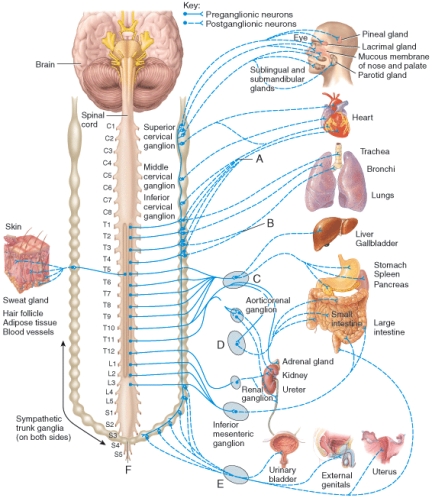
A)C
B)D
C)E
D)F
E)All of the choices are correct.

A)C
B)D
C)E
D)F
E)All of the choices are correct.

Unlock Deck
Unlock for access to all 82 flashcards in this deck.
Unlock Deck
k this deck
70
Which of the following labeled structures in the diagram are considered to be terminal ganglia of the ANS? 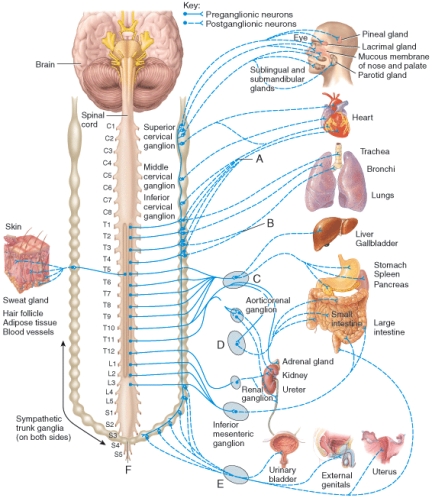
A)C
B)D
C)E
D)All of the choices are correct.
E)None of the choices is correct.

A)C
B)D
C)E
D)All of the choices are correct.
E)None of the choices is correct.

Unlock Deck
Unlock for access to all 82 flashcards in this deck.
Unlock Deck
k this deck
71
The parasympathetic branch of the autonomic nervous system prepares the body for the "fight-or-flight" response.

Unlock Deck
Unlock for access to all 82 flashcards in this deck.
Unlock Deck
k this deck
72
The ganglion labeled D in the diagram that stimulates saliva secretion from the parotid gland is called the 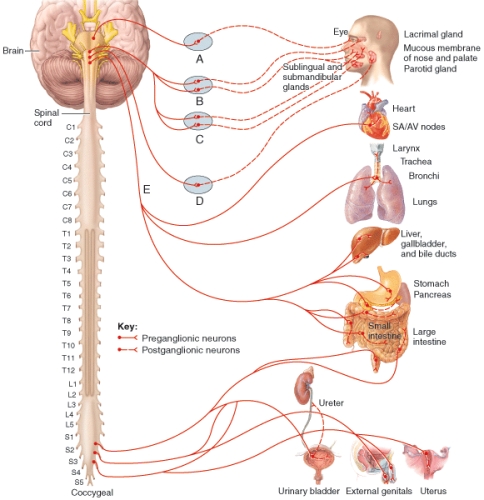
A)ciliary ganglion
B)otic ganglion
C)submandibular ganglion
D)pterygopalatine ganglion
E)salivary ganglion

A)ciliary ganglion
B)otic ganglion
C)submandibular ganglion
D)pterygopalatine ganglion
E)salivary ganglion

Unlock Deck
Unlock for access to all 82 flashcards in this deck.
Unlock Deck
k this deck
73
Instead of exercise to tone up muscles or the heart, some people use mind body exercise to tone up their parasympathetic nervous systems.

Unlock Deck
Unlock for access to all 82 flashcards in this deck.
Unlock Deck
k this deck
74
Briefly describe the major functional differences between the autonomic and somatic nervous system.

Unlock Deck
Unlock for access to all 82 flashcards in this deck.
Unlock Deck
k this deck
75
Name the two divisions of the autonomic nervous system and compare their general functions.

Unlock Deck
Unlock for access to all 82 flashcards in this deck.
Unlock Deck
k this deck
76
Which of the following neurotransmitter is used to stimulate the effectors in the motor pathway labeled B in the figure? 
A)epinephrine
B)acetylcholine
C)norepinephrine
D)epinephrine and norepinephrine
E)epinephrine and acetylcholine

A)epinephrine
B)acetylcholine
C)norepinephrine
D)epinephrine and norepinephrine
E)epinephrine and acetylcholine

Unlock Deck
Unlock for access to all 82 flashcards in this deck.
Unlock Deck
k this deck
77
What portion of the nervous system is shown in this diagram? 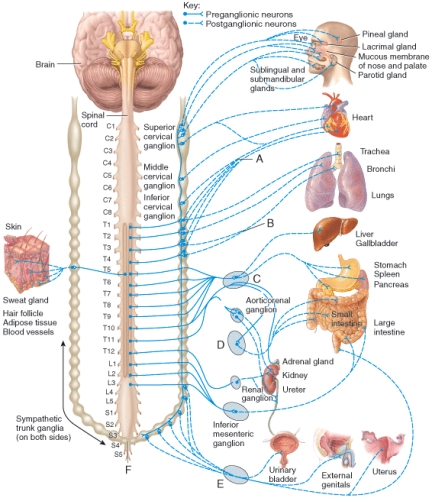
A)somatic nervous system
B)somatosensory nervous system
C)sympathetic division of ANS
D)parasympathetic division of ANS
E)enteric nervous system (ENS)

A)somatic nervous system
B)somatosensory nervous system
C)sympathetic division of ANS
D)parasympathetic division of ANS
E)enteric nervous system (ENS)

Unlock Deck
Unlock for access to all 82 flashcards in this deck.
Unlock Deck
k this deck
78
Which of the following cranial nerves (labeled E in the diagram)carries the parasympathetic outflow to the heart, lungs, and abdominal viscera? 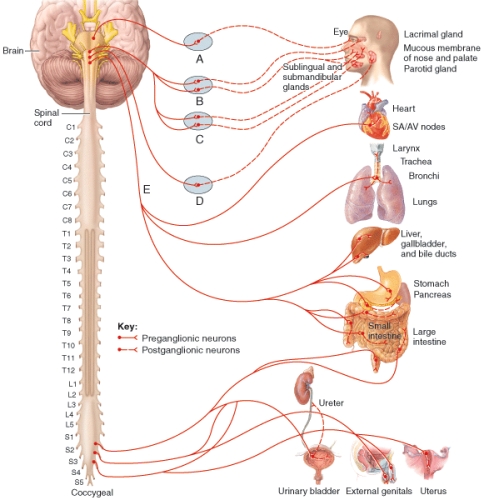
A)oculomotor (III)nerve
B)abducens (VI)nerve
C)vagus (X)nerve
D)facial (VII)nerve
E)glossopharyngeal (IX)nerve

A)oculomotor (III)nerve
B)abducens (VI)nerve
C)vagus (X)nerve
D)facial (VII)nerve
E)glossopharyngeal (IX)nerve

Unlock Deck
Unlock for access to all 82 flashcards in this deck.
Unlock Deck
k this deck
79
List the primary types of parasympathetic responses observed in humans.

Unlock Deck
Unlock for access to all 82 flashcards in this deck.
Unlock Deck
k this deck
80
The sympathetic division of the autonomic nervous system relaxes the ciliary muscle of the eye to adjust the lens for distant vision.

Unlock Deck
Unlock for access to all 82 flashcards in this deck.
Unlock Deck
k this deck



